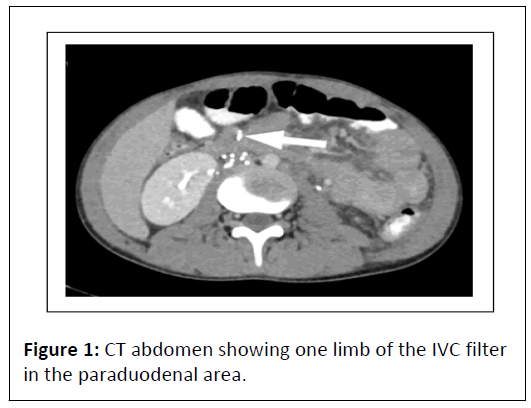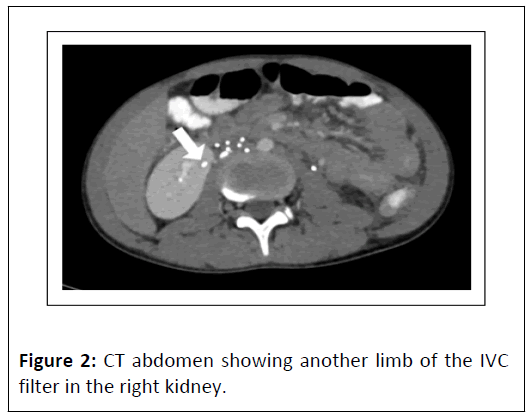Miraculous Survival of a Teenager after IVC Filter Migration
Imaan Jauhar*, Muhammad Mubashir, Misbah Tahir, Muhammad Ali and Bisma Rizwan
Department of Radiology, Liaquat National Hospital, Karachi, Pakistan
Published Date: 2023-07-04DOI10.36648/2471-8041.9.6.306.
Imaan Jauhar*, Muhammad Mubashir, Misbah Tahir, Muhammad Ali and Bisma Rizwan
Department of Radiology, Liaquat National Hospital, Karachi, Pakistan
- *Corresponding Author:
- Imaan Jauhar
Department of Radiology,
Liaquat National Hospital, Karachi,
Pakistan,
E-mail: imanjauhar02@gmail.com
Received date: June 05, 2023, Manuscript No. IPMCRS-23-16912; Editor assigned date: June 08, 2023, Pre QC No. IPMCRS-23-16912 (PQ); Reviewed date: June 19, 2023, QC No. IPMCRS-23-16912; Revised date: June 26, 2023, Manuscript No. IPMCRS-23-16912 (R); Published date: July 04, 2023, DOI: 10.36648/2471-8041.9.6.306.
Citation: Jauhar I, Mubashir M, Tahir M, Ali M, Rizwan B (2023) Miraculous Survival of a Teenager after IVC Filter Migration. Med Case Rep Vol.9 No. 6:306.
Abstract
Inferior Vena Cava (IVC) filters are widely used to treat thromboembolic conditions like Deep Vein Thrombosis (DVT) and Pulmonary Embolism (PE) when anticoagulation is not sufficient to stop their progression. The insertion of IVC filters is related to a number of complications and one such rare complication is its migration into abdominal organs. Here we are presenting a rare case of a 14 year old boy who presented to us with persistent abdominal pain after being treated for deep vein thrombosis and pulmonary embolism secondary to Chronic Pancreatitis with an ALN IVC filter, 4 years back.
Keywords
IVC filter migration; Chronic pancreatitis; Thromboembolism
Introduction
The ALN inferior vena cava filter is a retrievable IVC filter used in the treatment of deep vein thrombosis and pulmonary embolism secondary to failure of anticoagulants to work. It is implanted using the femoral or jugular vein approach [1]. Amongst the many types of IVC filters used by radiologists, the ALN type filter is found to have fewer complications like filter migration and perforation, compared to others [2]. Out of the many complications of IVC filters, migration and perforation into the abdominal organs is a rare occurrence and it presents with persistent abdominal pain and obstructive gastrointestinal symptoms [3].
Case Report
A 14 year old boy, known case of chronic pancreatitis since 4 years presented to the emergency department with complains of abdominal pain and constipation. He located the site of pain to be left upper quadrant and epigastrium radiating towards the back and left shoulder. The pain was colicky in nature and 6/10 on severity scale. His vitals at the time of presentation were as follows: Blood pressures of 110/60 mmHg, pulse 60, respiratory rate 20, oxygen saturation 98%, afebrile with clear chest. He complained worsening of his symptoms when wrong medication for constipation was dispensed to him; otherwise he was on omeprazole and lactulose for his disease. According to the patient’s parents he was being managed on a specific diet plan consisting of boiled vegetables, rice and porridge with certain restrictions placed by his pediatrician. On general physical examination the patient was well oriented with no other significant finding except for mild pallor and periorbital edema. Abdominal examination findings were also insignificant. His elder brother was also diagnosed with pancreatitis but his symptoms resolved after the treatment. His past medical history of multiple admissions for similar complains was significant including when he was sent to radiology department 4 years back after he presented to the hospital for similar episode of severe abdominal pain. His CT was done which was suggestive of thrombus. He was initially injected an anticoagulant but due to the development of a complication, he was kept on ventilator for 25 days after which, decision of a caval filter was made and the intervention was done. The filter type was ALN, which is a retrievable filter. Symptoms improved after implanting the filter and the patient was advised to get the filter removed after a certain period of time but the filter was not removed for around one and a half year due to the negligence of the parents of the patient, due to which he later developed the complication i.e. filter migration and hence again presented to the pediatric department, with persistent abdominal pain. A CT abdomen was performed by the radiologists, which showed that the filter migration occurred at and near multiple organs like the parduodenal area, right kidney and adjacent soft tissues. His workup was done and complete blood picture revealed hemoglobin of 9.8 g/dl, total leukocyte count of 7210/ microliters and platelets of 270,000 per microliter of blood. His liver function tests revealed ALT of 9 units per litre, ALP 173 IU/L, GGT of 28 units per litre and AST of 16 units per litre. His blood urea and creatinine levels were of 15 mg/dl and 0.49 mg/dl respectively. Furthermore ultrasound abdomen showed pancreas containing heterogeneous texture with dilated ducts measuring 5.0 mm, consistent with history of chronic pancreatitis. Endoscopic Retrograde Cholangiopancreatography (ERCP) showed few fragments of pancreatic duct stone at the ampullary region. His CT whole abdomen was done which was consistent with the findings of pancreatitis with stricture in the pancreatic duct in the head region with no definite thrombus in inferior vena cava. His para aortic nodes were enlarged and amylase levels were noted to be 281 units per litre and lipase levels of 195 units per litre. He was currently being managed on vancomycin and meropenem and his abdominal pain was lesser in severity. Removal of the limbs of the filter was not possible according to the Consultant Radiologist as table death could occur if any attempt to remove the limbs was made due to multiple migration sites (Figures 1 and 2).
Results and Discussion
According to a study, the risk of pulmonary embolism and deep vein thrombosis is higher in patients with chronic pancreatitis than the general population [4], which is treated using anticoagulants first, failure of which leads to the use of IVC filter. IVC filters came into popularity in 1970’s when they were massively used for the prevention of pulmonary embolism and for prophylaxis as well but rates of different complications are not uncommon [5]. There are two types of IVC filters, permanent and retrievable. The ALN type filter is a retrievable filter; having fewer complications compared to others and are widely used by radiologists [2]. Complications associated with the use of IVC filters are bleeding, thrombosis, migration, perforation and filter fracture [6]. Rates of filter migration vary from 0-11.8%. Reports have been made of IVC filter migration to the heart, pulmonary arteries, intrahepatic IVC, hepatic veins, renal veins, iliac veins and Superior Vena Cava (SVC). The rate of complications are also linked to the amount of time the filter is kept inside the human body as FDA approves the filter to be removed within 25 days to 54 days [5]. Perforation has been reported to occur in different organs such as duodenum, diaphragm, intestine, aorta and veins. On literature search we found migration and perforation are not a very common complication, in fact there isn't enough data present suggestive of diagnostic and treatment strategies however they are likely to occur if retrieval is not done within recommended time and the symptoms correspond to the site of the filter migration for example, abdominal pain in this particular case due to migration of the filter limbs in the abdominal viscera. In this regard the uniqueness of our case is that the boy, despite being 14 years old, suffered migration of struts near his right kidney, duodenum and imminent to aorta with only two arms still in place, however he still survived. The only complain he had been persistent abdominal pain which got relieved by appropriate medications. According to the senior radiologists, this is nothing but a miracle and they haven’t seen anything quite like this in their career.
Conclusion
Due to the rare occurrence of this complication, it is important for the clinicians and radiologists to be aware of this complexity and make timely filter removal essential so no case is jeopardized because not all patients are able to survive this kind of complication. The parents and the patients should also be counselled about the complications associated with the use of IVC filters so that they can make prompt decision.
References
- Pellerin O, Barral FG, Lions C, Novelli L, Beregi JP, et al. (2008) Early and late retrieval of the ALN removable vena cava filter: Results from a multicenter study. Cardiovasc Intervent Radiol 31: 889–96.
[Crossref], [Google Scholar], [Indexed]
- Deso SE, Idakoji IA, Kuo WT (2016) Evidence-based evaluation of inferior vena cava filter complications based on filter type. Semin Intervent Radiol 33: 93-100.
[Crossref], [Google Scholar], [Indexed]
- Jehangir A, Rettew A, Shaikh B, Bennett K, Jehangir Q, et al. (2015) IVC filter perforation through the duodenum found after years of abdominal pain. Am J Case Rep 16: 292-295.
[Crossref], [Google Scholar], [Indexed]
- Chung WS, Lin CL (2016) Comorbid risks of deep vein thrombosis and pulmonary thromboembolism in patients with chronic pancreatitis: A nationwide cohort study. J Thromb Haemost 16: 98-104.
[Crossref], [Google Scholar], [Indexed]
- Khan W, Zhang W, Clark V (2021) Persistent abdominal pain as rare complication of duodenal perforation from an inferior vena cava filter. Cureus 13: e13168.
[Crossref], [Google Scholar], [Indexed]
- Grewal S, Chamarthy MR, Kalva SP (2016) Complications of inferior vena cava filters. Cardiovasc Diagn Ther 6: 632-641.
[Crossref], [Google Scholar], [Indexed]

Open Access Journals
- Aquaculture & Veterinary Science
- Chemistry & Chemical Sciences
- Clinical Sciences
- Engineering
- General Science
- Genetics & Molecular Biology
- Health Care & Nursing
- Immunology & Microbiology
- Materials Science
- Mathematics & Physics
- Medical Sciences
- Neurology & Psychiatry
- Oncology & Cancer Science
- Pharmaceutical Sciences


